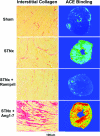Angiotensin-(1-7) infusion is associated with increased blood pressure and adverse cardiac remodelling in rats with subtotal nephrectomy
- PMID: 21091432
- PMCID: PMC3018845
- DOI: 10.1042/CS20100280
Angiotensin-(1-7) infusion is associated with increased blood pressure and adverse cardiac remodelling in rats with subtotal nephrectomy
Abstract
ACE (angiotensin-converting enzyme) 2 is expressed in the heart and kidney and metabolizes Ang (angiotensin) II to Ang-(1-7) a peptide that acts via the Ang-(1-7) or mas receptor. The aim of the present study was to assess the effect of Ang-(1-7) on blood pressure and cardiac remodelling in a rat model of renal mass ablation. Male SD (Sprague-Dawley) rats underwent STNx (subtotal nephrectomy) and were treated for 10 days with vehicle, the ACE inhibitor ramipril (oral 1 mg·kg(-1) of body weight·day(-1)) or Ang-(1-7) (subcutaneous 24 μg·kg(-1) of body weight·h(-1)) (all n = 15 per group). A control group (n = 10) of sham-operated rats were also studied. STNx rats were hypertensive (P<0.01) with renal impairment (P<0.001), cardiac hypertrophy (P<0.001) and fibrosis (P<0.05), and increased cardiac ACE (P<0.001) and ACE2 activity (P<0.05). Ramipril reduced blood pressure (P<0.01), improved cardiac hypertrophy (P<0.001) and inhibited cardiac ACE (P<0.001). By contrast, Ang-(1-7) infusion in STNx was associated with further increases in blood pressure (P<0.05), cardiac hypertrophy (P<0.05) and fibrosis (P<0.01). Ang-(1-7) infusion also increased cardiac ACE activity (P<0.001) and reduced cardiac ACE2 activity (P<0.05) compared with STNx-vehicle rats. Our results add to the increasing evidence that Ang-(1-7) may have deleterious cardiovascular effects in kidney failure and highlight the need for further in vivo studies of the ACE2/Ang-(1-7)/mas receptor axis in kidney disease.
Figures




Similar articles
-
Adverse cardiac effects of exogenous angiotensin 1-7 in rats with subtotal nephrectomy are prevented by ACE inhibition.PLoS One. 2017 Feb 13;12(2):e0171975. doi: 10.1371/journal.pone.0171975. eCollection 2017. PLoS One. 2017. PMID: 28192475 Free PMC article.
-
Chronic kidney disease: cardiac and renal angiotensin-converting enzyme (ACE) 2 expression in rats after subtotal nephrectomy and the effect of ACE inhibition.Exp Physiol. 2012 Apr;97(4):477-85. doi: 10.1113/expphysiol.2011.063156. Epub 2011 Dec 23. Exp Physiol. 2012. PMID: 22198016
-
Reduction in renal ACE2 expression in subtotal nephrectomy in rats is ameliorated with ACE inhibition.Clin Sci (Lond). 2010 Feb;118(4):269-79. doi: 10.1042/CS20090318. Clin Sci (Lond). 2010. PMID: 19698082 Free PMC article.
-
ACE2 of the heart: From angiotensin I to angiotensin (1-7).Cardiovasc Res. 2007 Feb 1;73(3):463-9. doi: 10.1016/j.cardiores.2006.09.006. Epub 2006 Sep 19. Cardiovasc Res. 2007. PMID: 17049503 Review.
-
ACE2 and vasoactive peptides: novel players in cardiovascular/renal remodeling and hypertension.Ther Adv Cardiovasc Dis. 2015 Aug;9(4):217-37. doi: 10.1177/1753944715597623. Epub 2015 Aug 13. Ther Adv Cardiovasc Dis. 2015. PMID: 26275770 Review.
Cited by
-
Diminazene Aceturate Improves Cardiac Fibrosis and Diastolic Dysfunction in Rats with Kidney Disease.PLoS One. 2016 Aug 29;11(8):e0161760. doi: 10.1371/journal.pone.0161760. eCollection 2016. PLoS One. 2016. PMID: 27571511 Free PMC article.
-
The effect of angiotensin 1-7 and losartan on renal ischemic/reperfusion injury in male rats.Res Pharm Sci. 2019 Oct 4;14(5):441-447. doi: 10.4103/1735-5362.268205. eCollection 2019 Oct. Res Pharm Sci. 2019. PMID: 31798661 Free PMC article.
-
The ACE2/Angiotensin-(1-7)/MAS Axis of the Renin-Angiotensin System: Focus on Angiotensin-(1-7).Physiol Rev. 2018 Jan 1;98(1):505-553. doi: 10.1152/physrev.00023.2016. Physiol Rev. 2018. PMID: 29351514 Free PMC article. Review.
-
Beneficial effects of the activation of the angiotensin-(1-7) MAS receptor in a murine model of adriamycin-induced nephropathy.PLoS One. 2013 Jun 7;8(6):e66082. doi: 10.1371/journal.pone.0066082. Print 2013. PLoS One. 2013. PMID: 23762470 Free PMC article.
-
Overexpression of angiotensin-converting enzyme 2 by renin-angiotensin system inhibitors. Truth or myth? A systematic review of animal studies.Hypertens Res. 2021 Aug;44(8):955-968. doi: 10.1038/s41440-021-00641-1. Epub 2021 Mar 10. Hypertens Res. 2021. PMID: 33750913 Free PMC article.
References
-
- Velez J. C. The importance of the intrarenal renin-angiotensin system. Nat. Clin. Pract. Nephrol. 2009;5:89–100. - PubMed
-
- Schiffrin E. L., Lipman M. L., Mann J. F. Chronic kidney disease: effects on the cardiovascular system. Circulation. 2007;116:85–97. - PubMed
-
- Burchill L., Velkoska E., Dean R. G., Lew R. A., Smith A. I., Levidiotis V., Burrell L. M. Acute kidney injury in the rat causes cardiac remodelling and increases angiotensin-converting enzyme 2 expression. Exp. Physiol. 2008;93:622–630. - PubMed
-
- Ferrario C. M. Angiotensin-converting enzyme 2 and angiotensin-(1–7): an evolving story in cardiovascular regulation. Hypertension. 2006;47:515–521. - PubMed
Publication types
MeSH terms
Substances
LinkOut - more resources
Full Text Sources
Other Literature Sources
Medical
Miscellaneous

